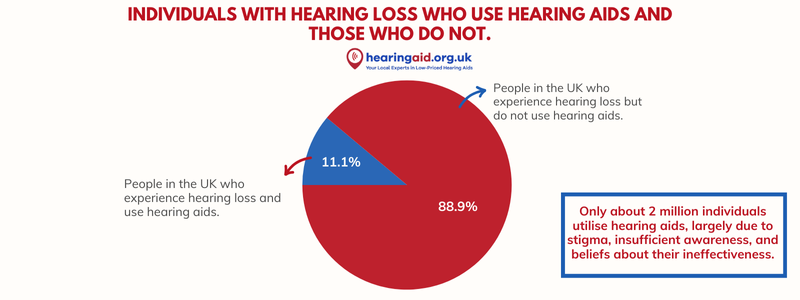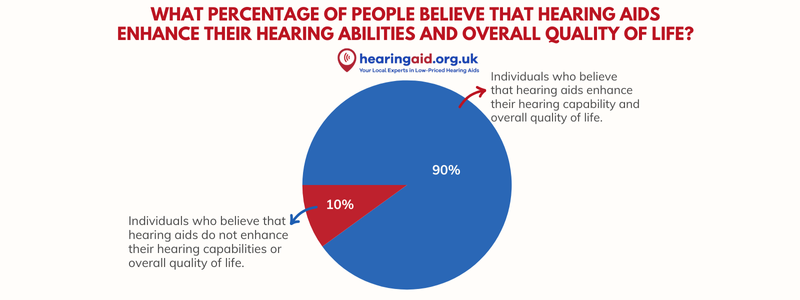
Head of Online Medical Content

Audiology Expert at Hearing Aid UK

UK Hearing Loss Statistics for 2025
Overview of UK Hearing Loss and Hearing Aids Statistics
Trouble hearing conversations? | Hearing Loss in the UK | Types of hearing loss | Economic impact of hearing loss | Key organisations and resources
Last Hearing Aid UK Update:
Hearing loss is a common issue in the UK
Trouble hearing conversations? You're not alone. Hearing loss affects approximately 18 million people in the UK, with higher prevalence among older adults, over 50% of the population over 50 and 80% over 70 experience hearing impairment.
This condition significantly impacts quality of life, as 62% report feelings of isolation and 87% feel it affects their daily lives.
This updated figure reflects a broader and more accurate understanding of hearing loss, now including those with milder hearing loss and those affected in just one ear.
The recalculation, released by RNID in June 2024, is based on new data from the 2021-22 UK Census, replacing earlier estimates from 2011.
Hearing loss classification
Hearing loss is classified as conductive, sensorineural, or mixed, yet only around 2 million people use hearing aids due to stigma, lack of awareness, and perceptions of ineffectiveness. Nonetheless, 90% of users report improved hearing and quality of life wearing hearing devices.
Recent technological advancements are expected to shift public perception, particularly with mainstream tech brands entering the hearing care space. For example, Apple’s AirPods Pro 2 now include a feature enabling them to act as “clinical-grade” hearing aids.
Following a five-minute hearing test, they adapt to support those with mild to moderate hearing loss, providing a more discreet alternative to traditional devices.
The NHS spends over £1 billion annually on hearing loss services, while untreated hearing loss costs the UK economy about £30 billion due to lost productivity. Awareness campaigns and regular assessments for those over 55 are essential for early detection and management.

Hearing Loss in the UK and what you need to know
- Prevalence: Approximately 18 million people in the UK are affected by hearing loss, equating to more than a quarter of the population. (Source: RNID)
The figure is accurate for now, but it’s important to note that this number could increase in future reports as the population grows and awareness improves.
- Tinnitus: Around 7.1 million people in the UK live with tinnitus, representing approximately 13.2% of the population. Many people with hearing loss also experience tinnitus, which affects about 1 in 10 adults overall.
Tinnitus, characterised by ringing, buzzing, or other sounds in the ears without an external source, often accompanies hearing loss and can significantly impact quality of life.
The relationship between hearing loss and tinnitus is complex. Many individuals experience both conditions simultaneously, with tinnitus sometimes being the first indication of underlying hearing damage.
This dual burden can amplify feelings of isolation and frustration, making early intervention and support important.
- Age factor: Is your hearing not what it used to be? Hearing loss becomes more common with age.
a) Is your hearing not what it used to be? It's common; over 50% of people over 50 in the UK have hearing loss.
b) 80% of people over the age of 70 experience some degree of hearing loss. (Source: Action on Hearing Loss)
These age-related figures are expected to remain stable, but with an ageing population, the numbers may rise over time. By 2031, it is estimated that 14.5 million people, approximately 20% of the UK population, will have hearing loss.
- Impact on quality of life:
a) 62% of those with hearing loss report feelings of isolation. Does hearing loss make you miss out on conversations? You're not alone.
b) 87% of those with hearing loss feel that it affects their daily lives. (Source: RNID)
The social impact of hearing loss extends beyond simple communication difficulties. People with untreated hearing loss often withdraw from social situations, leading to loneliness and reduced quality of life.
- Children: Approximately 50,000 children in the UK have hearing loss. Around half are born with it, whilst the other half lose their hearing during childhood. This represents a significant population requiring specialist support and early intervention.
1 to 2 babies in every 1,000 are born with permanent hearing loss in one or both ears. This increases to about 1 in 100 babies (1%) who have spent at least 48 hours in a special care unit.
8 out of 10 children will experience glue ear before the age of 10, and most babies with hearing loss are born into families with no history of hearing loss.
Dementia: There is a well-established link between hearing loss and dementia risk. Research has shown that mild hearing loss doubles the risk of developing dementia, moderate hearing loss leads to three times the risk, and severe hearing loss increases the risk five times
Hearing loss is associated with increased dementia risk for several reasons. Untreated hearing loss can result in social isolation, which has been shown to increase the likelihood of developing dementia.
The extra cognitive load required to process sounds with impaired hearing may contribute to cognitive decline.

Why has the number of people with hearing loss jumped in the UK from 12 million to 18?
Why did the number of people with hearing loss in the UK suddenly jump? Back in June 2024, RNID wrote an article explaining the change in this calculation.
Firstly, it now uses population data from the 2021-22 census instead of the 2011 census, which informed the previous estimate of 12 million people.
Secondly, it includes those with milder levels of hearing loss and those with hearing loss in one ear, who were previously excluded.
By incorporating anyone with any degree of hearing loss, whether in one ear or both, it is now accurately reflecting the true total of adults affected by hearing loss in the UK.
Types of hearing loss
- Conductive hearing loss: Conductive hearing loss is caused by problems in the outer or middle ear, which is often treatable.
- Sensorineural hearing loss: Sensorineural hearing loss results from damage to the inner ear or auditory nerve, usually permanent.
- Mixed hearing loss: Mixed hearing loss is a combination of conductive and sensorineural hearing loss.
Hearing aid usage
- People using hearing aids to improve their hearing: Approximately 2 million people in the UK use hearing aids, despite the significant number of those with hearing loss. (Source: Action on Hearing Loss)
While 2 million remains the current figure, it's likely that by 2026, more people will start using hearing aids, particularly as technology advances and becomes more affordable.
- Common concerns people have about hearing aids:
a) Stigma associated with wearing hearing aids.
b) Lack of awareness about available options.
c) Perception that hearing aids are ineffective or too expensive. (Source: RNID)
- Effectiveness:
a) 90% of hearing aid users report improvements in hearing ability and overall quality of life. (Source: NICE)
New developments such as AI-powered hearing devices and smartphone-integrated aids are helping combat outdated perceptions.
In fact, over 85% of users now report satisfaction with their hearing aids, particularly newer models offering noise cancellation, Bluetooth connectivity, and adaptive sound technology.

The economic impact of hearing loss
- Healthcare costs: The NHS spends over £1 billion annually on hearing loss-related healthcare services. (Source: NHS). This could grow as awareness spreads and the number of people affected by hearing loss continues to rise.
- Workforce impact: Untreated hearing loss costs the UK economy approximately £30 billion each year due to lost productivity. (Source: Action on Hearing Loss)
Recent scrutiny of NHS audiology services has revealed significant challenges. A 2025 NHS England report exposed that thousands of children had been misdiagnosed by underperforming audiology units.
With over 1,500 affected and nearly 500 facing moderate to severe long-term harm. This prompted renewed calls for better training, funding, and national oversight of hearing services.
Technological advancements in hearing aids
- Modern hearing aids: Features include Bluetooth connectivity, noise cancellation, and AI-driven adaptive technology.
In 2025, Apple’s launch of hearing aid functionality in its AirPods Pro 2 received wide attention. These devices allow users to take a hearing test and automatically adjust audio to suit mild to moderate loss, making them a viable and discreet hearing solution.
Mainstream tech brands like Apple, Google, and others are entering the hearing care space, which is likely to reduce stigma and increase usage, particularly among younger people or those with mild hearing loss.
- User satisfaction: Over 85% of hearing aid users express satisfaction with their devices, particularly with recent advancements. (Source: RNID)
Hearing loss awareness and education
- Awareness campaigns: Initiatives are important for increasing awareness of hearing loss and encouraging regular hearing checks, especially among older adults.
- Screening recommendations: NICE recommends regular hearing assessments for those over 55 and anyone experiencing symptoms of hearing loss. (Source: NICE)
NICE also updated its 2025 guidelines to recommend that individuals with hearing loss in both ears should be fitted with two hearing aids for improved speech clarity, especially in noisy settings. Ongoing follow-ups are encouraged to maintain effectiveness and device adjustment.
As awareness of early screenings grows, particularly for those aged 55 and older, we can expect more frequent checks and improved outcomes for people with hearing loss.
Key organisations and resources for hearing loss and hearing aids
- NHS (National Health Service): Provides comprehensive health information and services. Website - https://www.nhs.uk/
- Action on Hearing Loss: A leading charity focused on supporting those with hearing loss and promoting research. Website - https://actionhearingloss.org.uk/
- Royal National Institute for Deaf People (RNID): Offers support and information for those affected by hearing loss and tinnitus. Website - https://rnid.org.uk/
- Office for National Statistics (ONS): Publishes data and reports related to health, including hearing loss. Plus, any grants you might be entitled to. Website - https://ONS.gov.uk
- National Institute for Health and Care Excellence (NICE): Provides guidelines and recommendations regarding hearing health. Website - https://www.nice.org.uk/
Why Choose Us?
- FREE Hearing Tests
- Best Hearing Aids and Prices
- FREE Aftercare for Life
- FREE Home Visits
- 200+ Local Audiologists
- 60 Day Money Back Guarantee
UK Hearing loss statistics 2025 conclusion
Understanding the statistics related to hearing loss and the use of hearing aids in the UK can help inform public health strategies and improve access to services.
This, ultimately, enhances the quality of life for millions affected by hearing loss.
For journalists, these statistics provide a foundation for articles that raise awareness, promote understanding, and advocate for improved hearing health services.
Other hearing loss awareness articles you might like...
 Tips for hearing in restaurants
Tips for hearing in restaurants  The impact of hearing loss and relationships
The impact of hearing loss and relationships  Hearing Loss and Mental Health
Hearing Loss and Mental Health Our specialist service includes:
Do not spend hundreds of pounds without getting a second opinion from us.
Please call us on 0800 567 7621
 Not only are the prices great, but the service is fantastic! Many thanks to your team.
Not only are the prices great, but the service is fantastic! Many thanks to your team.Watch RNID video about hearing loss below
What's included in our hearing aid prices?
FAQs
In general, any audiologist will always recommend to you the hearing aid model that best suits your needs. Here is a useful checklist to make sure that is the case.
- Audiologist's level of knowledge: The audiologist you have seen will hopefully have a wide knowledge of all available hearing aids; however, some will only be familiar with a small number of brands and, therefore, may not really be in a position to know which model is the best for you. It is OK to challenge their recommendation and ask them to justify why this particular brand is the one for you.
- Do research: Read about the hearing aid that was recommended. Does it seem like it will suit your lifestyle? Does it have more or fewer features than you need?
- Be aware of sales targets: Many high street retailers have specific tie-ins to a particular manufacturer/brand. The hearing aid they have suggested may still be the correct one for you, but do your research so that you know why they might have recommended it.
If you have significant hearing loss in both ears, you should be wearing two hearing aids. Here are the audiological reasons why:
Localisation: The brain decodes information from both ears and compares and contrasts them. By analysing the minuscule time delays as well as the difference in the loudness of each sound reaching the ears, the person is able to accurately locate a sound source.
Simply put, if you have better hearing on one side than the other, you can't accurately tell what direction sounds are coming from.
Less amplification is required: A phenomenon known as “binaural summation” means that the hearing aids can be set at a lower and more natural volume setting than if you wore only one hearing aid.
Head shadow effect: High frequencies, the part of your hearing that gives clarity and meaning to speech sounds, cannot bend around your head. Only low frequencies can. Therefore, if someone is talking on your unaided side, you are likely to hear that they are speaking, but be unable to tell what they have said.
Noise reduction: The brain has its own built-in noise reduction, which is only really effective when it is receiving information from both ears. If only one ear is aided, even with the best hearing aid in the world, it will be difficult for you to hear in background noise as your brain is trying to retain all of the sounds (including background noise) rather than filtering them out.
Sound quality: We are designed to hear in stereo. Only hearing from one side sounds a lot less natural to us.
Fancy some further reading on this topic? You can read about why two hearing aids are better than one in our article, hearing aids for Both Ears, here
For most people, the main benefit of a rechargeable hearing aid is simple convenience. We are used to plugging in our phones and other devices overnight for them to charge up. Here are some other pros and cons:
For anybody with poor dexterity or issues with their fingers, having a rechargeable aid makes a huge difference, as normal hearing aid batteries are quite small and some people find them fiddly to change.
One downside is that if you forget to charge your hearing aid, then it is a problem that can't be instantly fixed. For most, a 30-minute charge will get you at least two or three hours of hearing, but if you are the type of person who is likely to forget to plug them in regularly, then you're probably better off with standard batteries.
Rechargeable aids are also a little bit bigger and are only available in Behind-the-Ear models.
Finally, just like with a mobile phone, the amount of charge you get on day one is not going to be the same as you get a few years down the line. Be sure to ask what the policy is with the manufacturer's warranty when it comes to replacing the battery.
For most people, the answer is yes. But it's never that simple.
The majority of hearing problems affect the high frequencies a lot more than the low ones. Therefore, open fitting hearing aids sound a lot more natural and ones that block your ears up can make your own voice sound like you are talking with your head in a bucket. Therefore, in-ear aids tend to be less natural.
However, the true answer is we can't tell until we have had a look in your ears to assess the size of your ear canal, and until we have tested your hearing to see which frequencies are being affected.
People with wider ear canals tend to have more flexibility, also there are open fitting modular CIC hearing aids now that do not block your ears.
There is also the age-old rule to consider, that a hearing aid will not help you if it's sat in the drawer gathering dust. If the only hearing aid you would be happy wearing is one that people can't see, then that's what you should get.
Most people can adapt to any type of hearing aid, as long as they know what to expect. Have an honest conversation with your audiologist as to what your needs are.
Generally speaking, six or more. Unless it's none at all. The number of channels a hearing aid has is often a simplistic way an audiologist will use to explain why one hearing aid is better than another, but channels are complex, and it is really not that straightforward. Here are some reasons why:
Hearing aids amplify sounds of different frequencies by different amounts. Most people have lost more high frequencies than low, and therefore need more amplification in the high frequencies. The range of sounds you hear is split into frequency bands or channels, and the hearing aids are set to provide the right amount of hearing at each frequency level.
Less than six channels, and this cannot be done with much accuracy, so six is the magic number. However, a six-channel aid is typically very basic with few other features and is suitable only for hearing a single speaker in a quiet room. The number of channels is not what you should be looking at; it's more the rest of the technology that comes with them.
As a final note, different manufacturers have different approaches. One method is not necessarily better than any other. For example, some manufacturers have as many as 64 channels in their top aids. Most tend to have between 17 and 20. One manufacturer has no channels at all.
Manufacturer's warranties typically last between 2-5 years, depending on the brand and model, and cover defects in materials and workmanship. This includes repairs for component failures, electronic malfunctions, and manufacturing defects, but excludes damage from misuse, accidents, or normal wear. Most manufacturers also include loss and damage insurance for the first year.
We handle all warranty claims on your behalf, liaising with manufacturers and ensuring you get replacement devices quickly when needed. This comprehensive warranty coverage, combined with our lifetime aftercare, gives you complete peace of mind.
Our hearing tests are completely free, whether at our clinics or in your home. Unlike other providers who charge £30-£100 for home visits, we believe hearing healthcare should be accessible without financial barriers. Our comprehensive assessments include examination by a registered audiologist, audiogram results, and personalised recommendations.
All testing, future adjustments, and ongoing support are included at no extra cost. While NHS tests are also free, typical 6-week waiting periods often lead people to seek immediate private testing. We provide prompt, professional assessments that fit your schedule and budget.
Yes, we offer completely free home visits throughout the UK, and this service is included in our prices with no additional charges. Home visits are particularly valuable for people with mobility issues, busy schedules, or those who simply prefer the comfort and convenience of their own environment.
Our audiologists can conduct full hearing tests, fit hearing aids, and provide ongoing support in your home. This service sets us apart from many providers who either don't offer home visits or charge extra for them.
We can offer prices up to 40% lower than high street retailers because of our business model. As a network of 200+ independent audiologists, we don't have the massive overheads of large retail chains - no expensive high street premises, no sales targets pushing audiologists to sell the most expensive options, and no costly marketing campaigns.
However, we maintain the same buying power as the big chains because we purchase on behalf of our entire nationwide network. This means you get access to the same premium hearing aids with professional service, but at genuinely competitive prices.
We offer a comprehensive 60-day money-back guarantee, which gives you twice the industry standard time to properly assess whether your hearing aids are right for you. This extended period recognises that adjusting to hearing aids takes time, and your brain needs several weeks to adapt to the amplified sounds.
Unlike many providers who offer just 30 days, we believe 60 days gives you the confidence to test your hearing aids in all the situations that matter to you - from quiet conversations at home to busy restaurants and outdoor activities.
Ask the Experts
6 Morton Lane
Walkwood
Redditch
Worcestershire
B97 5QA
Latest Launch
When we refer to a product as 'Latest Launch', we mean it is the latest to be released on the market.
New
When we refer to a product as 'New', we mean that the product is the newest hearing aid model on the market.
When we refer to a product as 'Superseded', we mean that there is a newer range available which replaces and improves on this product.
Older Model
When we refer to a product as an 'Older Model', we mean that it is has been superseded by at least two more recent hearing aid ranges.
